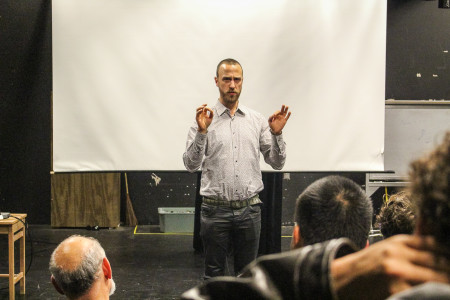Emily Ricker
rickerem@grinnell.edu
Gender, technology, music and sex all came together in a presentation on Tuesday, entitled “Sexing Sound.” The College welcomed sound artists Annie Goh and Mark Barden to discuss and exhibit their work.
The program was an adaptation of one by the same name put on by the Goethe-Institut Chicago last week. Both artists played major roles in the institute’s program. According to the institute’s website, the program is intended to “present and examine the manifestations, contestations and provocations of gender in contemporary music and sound art.”
With a lecture by Goh and an interactive sound installation by Barden as the main features, the program was atypical from many other presentations at Grinnell.

Goh’s work is unique to say the least.
“As far as I know, I’m the only person making cyberfeminist computer music,” Goh said in her lecture.
Because the audience was unlikely to be familiar with cyberfeminist computer music, Goh spent time breaking down exactly what the term means. She explained cyberfeminism as a movement of resistance to the cisgender male domination of technology and cyberspace that occurred mainly in the 1990s.
Goh is particularly motivated to explore the reasons why women and people identifying outside the gender binary are underrepresented in her genre.
“There’s not many women very prominent in electronic music,” Goh said.
She is looking to probe at the reasons why with the goal of ultimately disrupting that norm. Computer music, Goh explained, is music that “only computers can make.” She creates her music with a program called Gendy, which from an outsider’s perspective closely resembles a computer-programming platform.
“[The pieces are] a provocation to fuse the mathematical, generative possibilities within sound with progressive gender politics,” Goh described in her PowerPoint presentation.
The night’s other presenter, Mark Barden, took a different approach when addressing the topic of “sexing sound.” Also a sound artist, Barden’s project for the event at the Goethe-Institut was a multi-speaker sound installation inspired by noises heard in European “dark rooms” – places where men go to engage in anonymous sexual encounters.

While that might seem a bit scandalous at first, Barden said the sounds in his installation were not recognizably sexual.
In fact, Barden creates his pieces by first capturing the natural sounds then isolating just the strongest sign tones from each. By the time the sounds are ready for the listener, the source and context of the sounds are not obvious.
This proved true for listeners at the program. From directly inside the entrance to the “dark room,” the sound fell somewhere between alien abduction and abandoned pier at midnight.
For such a unique and labor-intensive piece, Barden’s installation has a specific goal. Namely, “stripping this of whatever sort of judgment one might have of these places,” Barden said in his presentation.
He aims to rid the stigmas by exploring “what sounds bodies make when they’re experiencing pleasure in these spaces that are designed to let people be free of their identities.”
Barden chose the medium of an installation piece because it gives the listener agency in choosing how to experience the material.
“That’s something that really excites me about installation art or sound art. [It] gives me a chance to explore a piece on my own terms,” Barden said.




















































